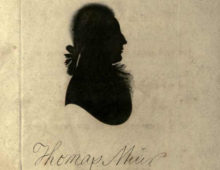Tagged with Portraits
Resource : Portrait of Mary Wollstonecraft
Mary Wollstonecraft was a revolutionary writer who made a powerful case for educating and emancipating women. She is still regarded as one of the founders of modern British feminism.
Resource : Portrait of James Barry
Born Margaret Bulkley, James Barry lived most of his life as a man, qualifying as a doctor and becoming an accomplished and respected military surgeon. His identity as a woman was only revealed when his maid laid him out after his death. It is not known whether Barry identified as a man or whether he simply kept up a disguise in order to have a medical career, at a time when women were denied this opportunity.
Resource : Ira Aldridge as Othello, the Moor of Venice
Ira Aldridge (1807 – 1867) was the first Black actor to play leading Shakespearian roles on the stage, both in Britain and across Europe.
Resource : Portrait of Elizabeth Fry
Elizabeth Gurney Fry (1780 – 1845) was a social reformer, best remembered for her work improving conditions for people in prison. She was the first female prison reformer in Europe, and probably the best known of her time. She became known as ‘the angel of the prisons.’
Resource : William Godwin
The writer, William Godwin is perhaps not the most famous but was one of the most influential British radicals and political philosophers of the Age of Revolution. He was married to the revolutionary feminist writer Mary Wollstonecraft, and was the father of Frankenstein author Mary Shelley. He established the Juvenile Library and had a powerful influence on the Romantic poets, including William Wordsworth and his son-in-law Percy Shelley.
Resource : Queen Marie Antoinette of France and two of her children walking in The Park of Trianon
Marie Antoinette was the wife of the last King of France, Louis XVI, before the French Revolution overthrew the monarchy. She was known for extravagance and indulgence, and was despised by the people of France. She came to symbolise the Ancien Régime – a long-standing system where the monarchy, aristocracy and Catholic Church held absolute power and privilege over ordinary people.
Resource : Angelica Kauffmann
Angelica Kauffman was a successful and influential artist of the mid-late 1700s, and one of only two female founder members of the Royal Academy of Arts, in London in 1768. Despite also being a skilled portrait and landscape artist, she is remembered primarily for her success as a history painter. This was seen as the most elite category in academic painting at the time, and an unusual choice for a female artist.
Resource : Sir Joshua Reynolds’ portrait of Sir Banestre Tarleton
This portrait shows the flamboyant and controversial figure Sir Banestre Tarleton, a cavalry officer best known as commander of the ‘Tarleton Raiders’ during the American war of independence. It was painted by Sir Joshua Reynolds, the leading British portrait painter of the 18th century. Reynolds was a founding member of the Royal Academy and its first President, and was knighted by King George III.
Resource : Bust of Jean-Jaques Dessalines (1758 – 1806)
Jean-Jacques Dessalines (1758 – 1806) was born into slavery in St Domingue (now Haiti) on the Caribbean island of Hispaniola. Following a mass uprising of enslaved people of African origin – the only successful slave revolt in history – and a series of bloody battles and reprisals, Dessalines eventually became the first ruler of Haiti, the world’s first modern independent ‘black’ republic. The events in St Domingue became known as the Haitian Revolution.
Resource : Toussaint Louverture, Chief of the French Rebels in St Domingo
Toussaint Louverture (1743 – 1803) was born into slavery in St Domingue (now Haïti) on the Caribbean island of Hispaniola. In 1791 he led the first – and only – successful uprising of enslaved Africans. Although he died before the revolution spawned a nation, in 1804 Haiti became the first independent ‘black’ republic and contributed to the decline of the transatlantic slave trade. The events in St Domingue became known as the Haitian Revolution. This and other depictions of Louverture (in print and portraiture) reflected the high levels of fascination and respect expressed around the world for a radical figure who had refused to yield and who surmounted all foes in the revolutionary contests.


